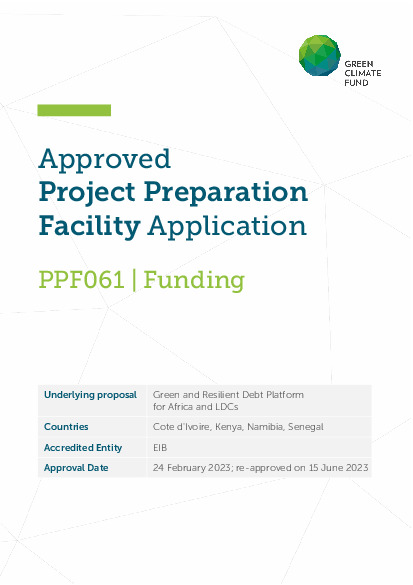Green and Resilient Debt Platform for Africa and LDCs
Despite the fact that Cote d’Ivoire, Kenya, Namibia, Senegal, and other African countries and LDCs are most affected by climate change, they have the least access to climate finance, particularly for adaptation. In 2019/2020, off the total climate finance provided (estimated at USD 632 billion), only 3% flowed to sub-Saharan Africa, and off the total climate finance to developing countries ($79.6 billion), 25% flowed to sub-Saharan Africa. Off the total climate finance provided and mobilized by developed countries for developing countries - USD 79.6 billion in 2019 – only USD 15.4 billion went to LDCs. Notably, while adaptation can reduce investment risk and hence the cost of capital, adaptation finance remains extremely low at 7% of total climate finance in 2019/2020.
Green bonds are demonstrating potential to address the climate financing gap, growing to $523 billion in 2021 and reaching a total market size of $2 trillion at the end of quarter 3 in 2022. Green bonds offer a number of benefits, notably, they provide additional sources of finance, diversify the investor base, attracting ESG and new sources of public climate finance specifically dedicated for green bonds, and offer portfolio diversification for investors. Green bonds also enable long-term financing, notably for climate resilient infrastructure, with potential for institutional investors and can potentially reduce the cost of debt finance through the ‘greenium’ - concession on new green bond issuance.
However, Africa accounted for only 0.077% of issuances in 2021. African countries face exorbitant interest rates, essentially shutting them out from global capital markets because of a number of underlying barriers that increase investor risks. These barriers include: weak domestic investment environments and limited integration between climate risks, impacts and opportunities, notably related to credit rating; lack of a pipeline of bankable, green labelled investments with adequate project preparation support; limited capacity of domestic financial systems and institutions to issue and invest in green bonds; and insufficient availability and access to large-scale guarantee mechanisms; limited anchor investment from public institutions to attract private investors
Furthermore, green bonds to date have focused primarily on GHG mitigation efforts with a much lower emphasis on climate resilience and ‘blue’ sectors, despite the role that adaptation investments can play in reducing investment risk and potentially improving credit ratings over time.
Public finance is required to support African countries address these barriers and demonstrate that increased investment in resilience reduces investment risk, creating a virtuous cycle. African countries, including Cote d’Ivoire, Kenya, Namibia and Senegal have indicated interest in leveraging the potential of green bonds to scale up access to climate finance. Cote d’Ivoire issued its first green bond in 2021. The bond - CFA Fr10bn ($18.1m) 7.5% eight-year private placement - was issued by Emergence Plaza, the owner of the Cosmos Yopougon shopping centre in Abidjan focused on waste recycling. In 2019, British real estate developer Acorn Holdings issued the first green bond in Kenya raising Sh4.3 billion (about USD 40 million) of the targeted Sh5 billion to finance green and environmentally friendly accommodation for 5,000 university students in Nairobi. Namibia has issued 3 green bonds (mostly across 3 and 5 year notes) by financial corporates (including one domestic financial institution), which have been allocated to towards green buildings and renewable energy generation projects. Senegal has recently developed its ESG framework to guide SDG bond issuances. These issuances and frameworks are important milestones for climate finance in Cote d’Ivoire, Kenya, Namibia and Senegal. They indicate the huge untapped potential of green debt capital markets to scale up both countries’ long-term access to climate finance, including from the private sector, to meet their NDC and NAP goals.
The objective of this PPF is to tap into this potential by supporting the design and establishment of a Green and Resilient Debt Platform (GRDP) to unlock public and private climate finance at scale through the issuance of green bonds, notably for adaptation in Africa and LDCs. The PPF will examine the potential impact, feasibility and structure of the GRDP within the ecosystem of the EU’s Global Green Bond Initiative (GGBI), which aims to unlock up to $2 billion with a total impact of $15-20 billion.
